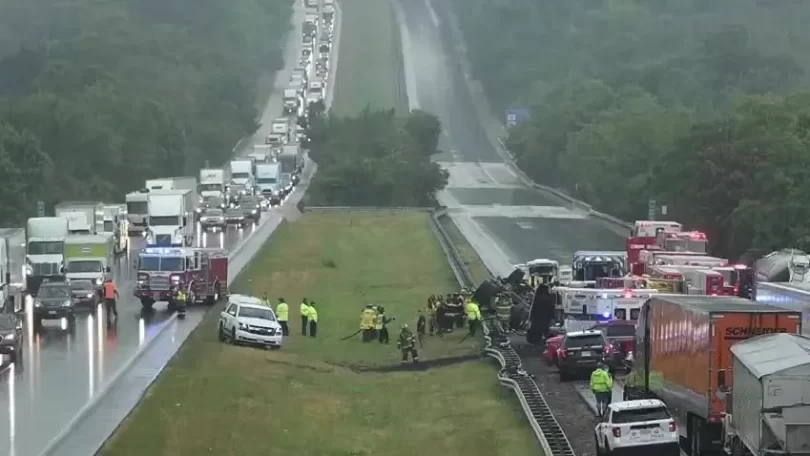An early morning crash in Bridgewater, New Jersey, left one driver unconscious and trapped inside a burning vehicle. Around 2 a.m., Peter Della-Ventura collided with the back of a Freightliner tanker truck on Route 22 westbound, igniting both vehicles in flames. Quick action by a nearby police officer saved Della-Ventura from life-threatening injuries, and several rescue teams provided additional support. Both Della-Ventura and his passenger were transported to Robert Wood Johnson University Hospital with non-life-threatening injuries. The incident remains under investigation as authorities seek to determine what caused the dangerous collision.
Contents
- 1 What Caused the Crash on Route 22 in Bridgewater?
- 2 How Do Authorities Determine Liability After a Fire Crash?
- 3 Why Are Highway Rear-End Collisions Particularly Dangerous?
- 4 What Immediate Actions Should Drivers Take After a Vehicle Fire?
- 5 What Injuries Are Common in Car Fires and Crash Rescues?
- 6 Why Is Early Legal Consultation Important After Fire-Related Crashes?
- 7 Conclusion: How Quick Action Protects Crash Victims After Highway Fires
What Caused the Crash on Route 22 in Bridgewater?
The crash on Route 22 in Bridgewater happened when Peter Della-Ventura’s Hyundai Elantra struck the back of a Freightliner tanker truck traveling westbound. Early indications suggest that the Elantra was moving at high speed when it impacted the rear of the much larger truck. Accidents involving slower or stationary heavy trucks are extremely dangerous because smaller vehicles tend to underride the trailer or absorb full-force impact. Driver fatigue, distraction, or failure to adjust speed near large commercial vehicles are common factors that contribute to rear-end collisions on highways. Investigators will review surveillance footage, physical evidence, and witness accounts to piece together the moments leading up to the crash.
How Do Authorities Determine Liability After a Fire Crash?
Authorities determine liability after a fire crash by examining vehicle movement patterns, driver behavior, mechanical conditions, and roadway circumstances. They assess factors such as following distance, braking activity, and driver impairment through toxicology reports and physical examinations. For example, if Della-Ventura was distracted or failed to maintain a safe distance from the tanker truck, liability would lean heavily on him. Investigators also review whether the truck driver adhered to traffic laws and was properly marked for visibility, especially during nighttime travel. Victims seeking compensation after similar incidents rely on experienced Attorneys to protect their rights and recover damages for injuries and losses.
Why Are Highway Rear-End Collisions Particularly Dangerous?
Highway rear-end collisions are particularly dangerous because of the high speeds involved and the substantial weight differences between vehicles. Colliding with a tanker truck carrying fuel or chemicals amplifies the risk of fire, explosion, and catastrophic injuries. In Bridgewater, the immediate eruption of flames created life-threatening conditions within seconds of impact. Smaller passenger cars offer little structural protection against larger trucks, leading to crush injuries, burns, and unconsciousness. Emergency rescues, such as the officer’s heroic intervention in this case, are the only reason victims survive such violent encounters.
What Immediate Actions Should Drivers Take After a Vehicle Fire?
Drivers involved in collisions where fires erupt must react immediately to protect their lives and the lives of others. Several urgent steps should be taken right away, as explained below:
- Exit the vehicle quickly if able: Remaining inside a burning car increases the risk of smoke inhalation, burns, and fatal injuries. Escaping the cabin and moving to a safe distance should be a first priority.
- Call emergency services immediately: Even if help appears on the way, ensuring that fire departments and paramedics are alerted shortens response times.
- Warn other motorists when safe: Flashers, hazard triangles, or shouting can alert oncoming drivers to danger, helping avoid secondary accidents.
- Avoid returning to the vehicle: Returning to retrieve belongings exposes individuals to explosions or toxic fumes. Human life must always come first in fire incidents.
- Follow emergency responders’ instructions: Firefighters and police assess danger zones and evacuation routes based on evolving conditions, making it critical to follow directions without delay.
What Injuries Are Common in Car Fires and Crash Rescues?
Injuries common in car fires and crash rescues include burns, smoke inhalation injuries, broken bones, and traumatic brain injuries. Burns occur quickly inside a burning vehicle, affecting the skin, respiratory passages, and eyes even before direct flame contact. Smoke inhalation damages the lungs and impairs oxygen delivery, resulting in unconsciousness before external injuries appear. Impact trauma from the crash itself, such as broken ribs or concussions, complicates extraction efforts and slows recovery. Immediate hospital evaluation remains necessary even if visible injuries seem minor because internal damage from heat or smoke can worsen rapidly without early intervention.
Why Is Early Legal Consultation Important After Fire-Related Crashes?
Early legal consultation is important after fire-related crashes because critical evidence disappears quickly while insurance companies begin assessing liability defenses. Fire scenes destroy physical evidence that would normally clarify fault, such as vehicle skid marks, mechanical defects, or dashboard readings. Witness memories fade, and companies responsible for commercial trucks initiate investigations designed to protect their interests. Consulting an attorney ensures accident victims preserve necessary proof and file claims before procedural deadlines expire. Early legal action also ensures that victims receive proper medical assessments linked to the crash, strengthening future injury claims.
Conclusion: How Quick Action Protects Crash Victims After Highway Fires
Major highway crashes involving fire demand immediate action from everyone involved to minimize injury and protect rights. Drivers escaping burning vehicles, witnesses calling for help, and legal representatives securing evidence each play vital roles. Responsibility for the devastating consequences of rear-end collisions depends on careful evidence collection and thorough investigation. Quick thinking at the scene, followed by decisive legal representation, ensures that victims achieve recovery and hold responsible parties accountable.

